
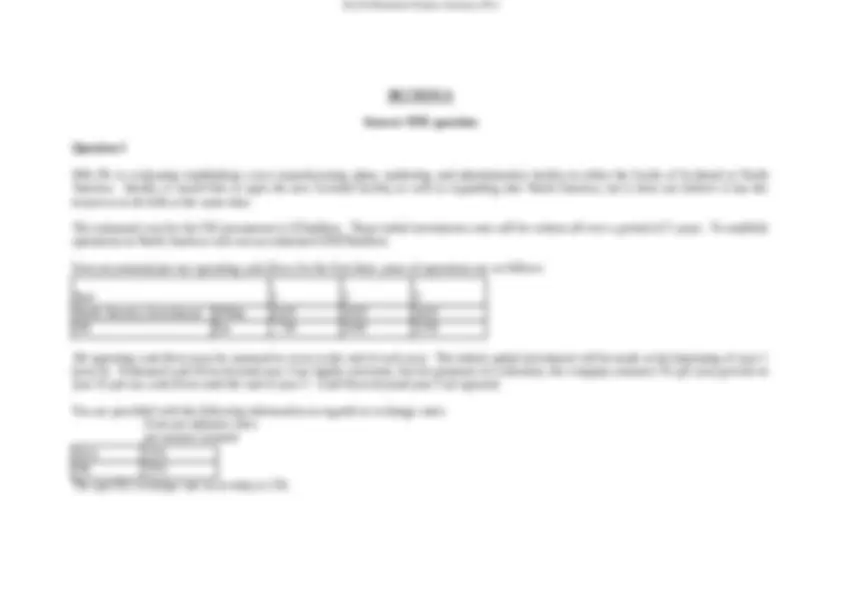
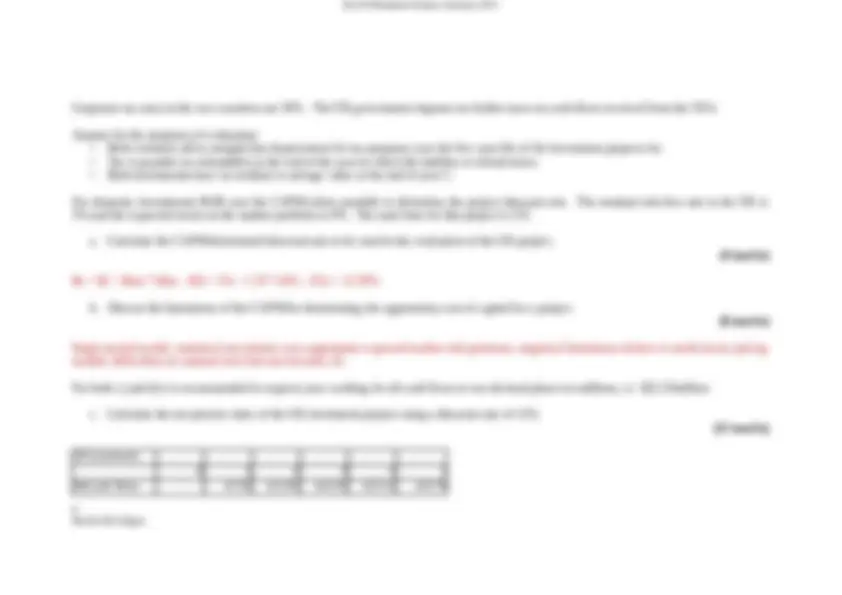
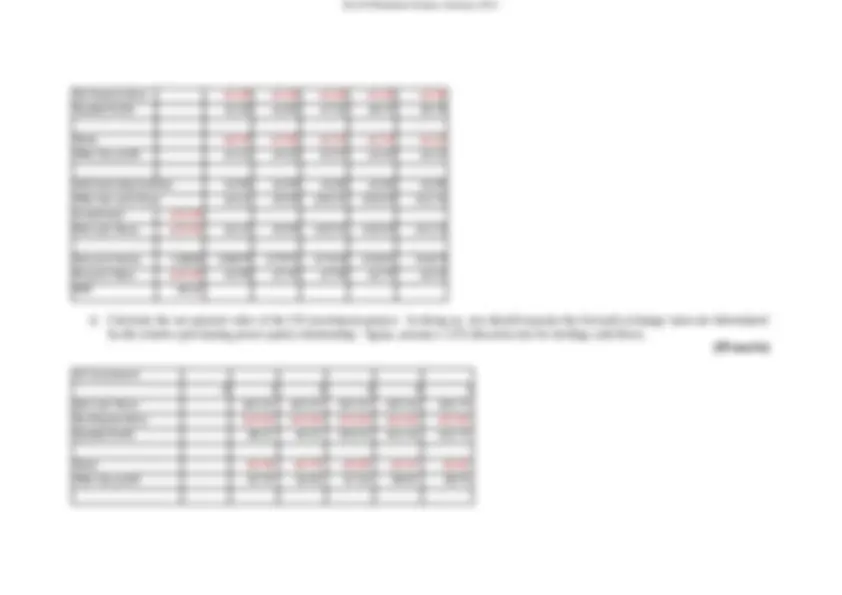
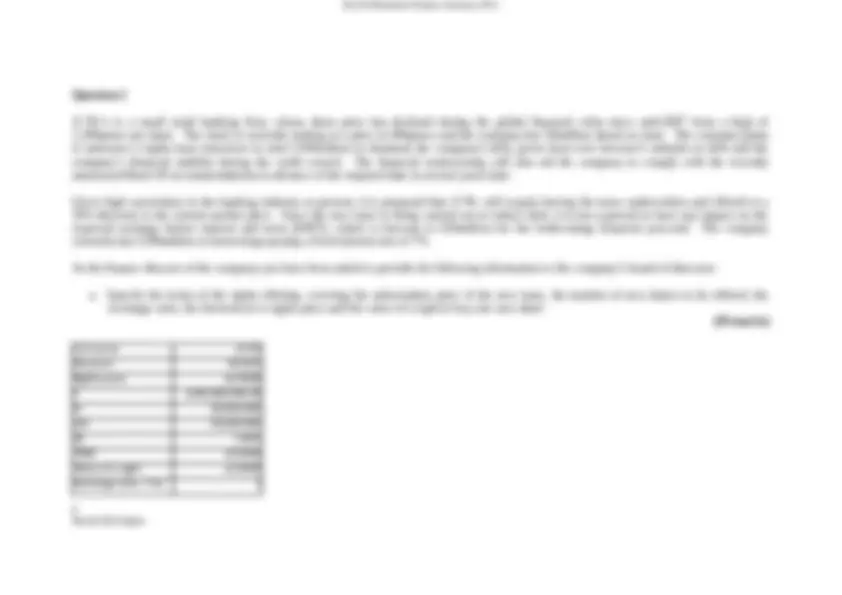
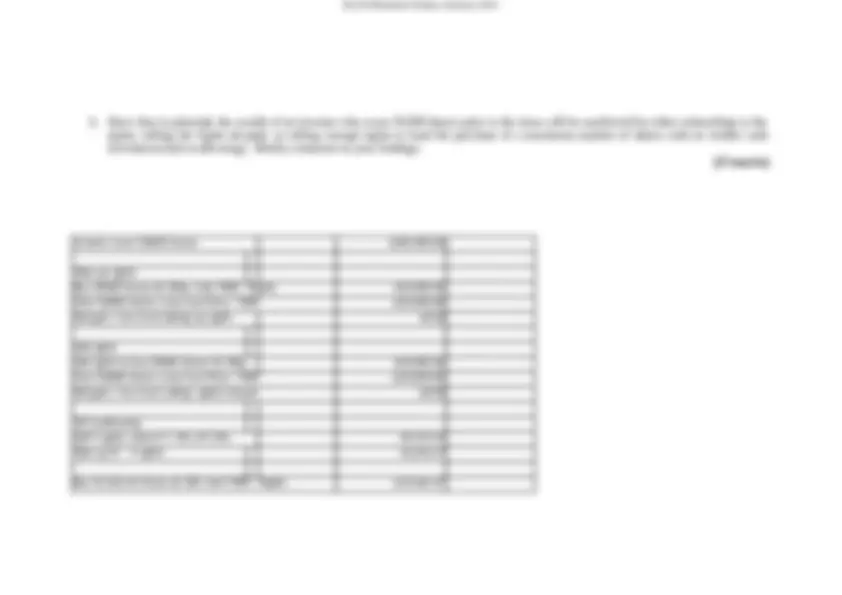
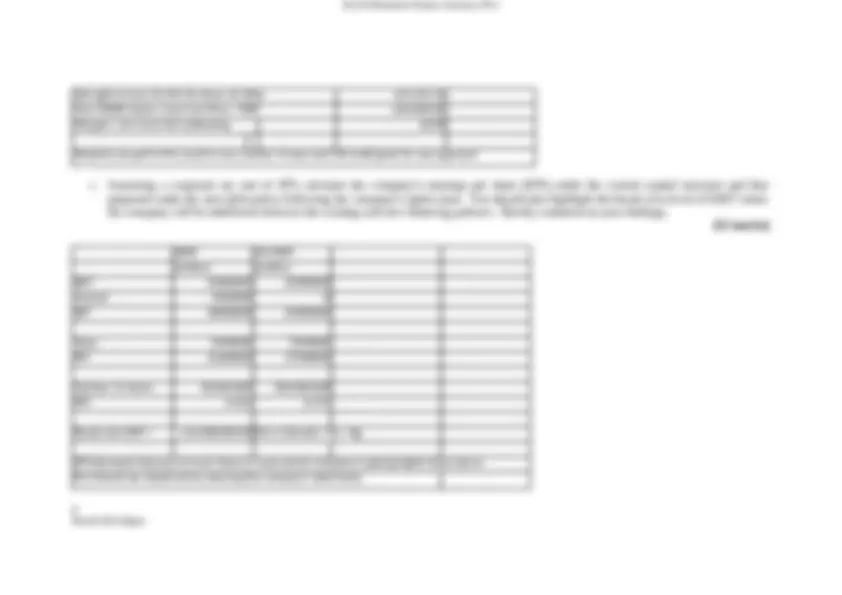
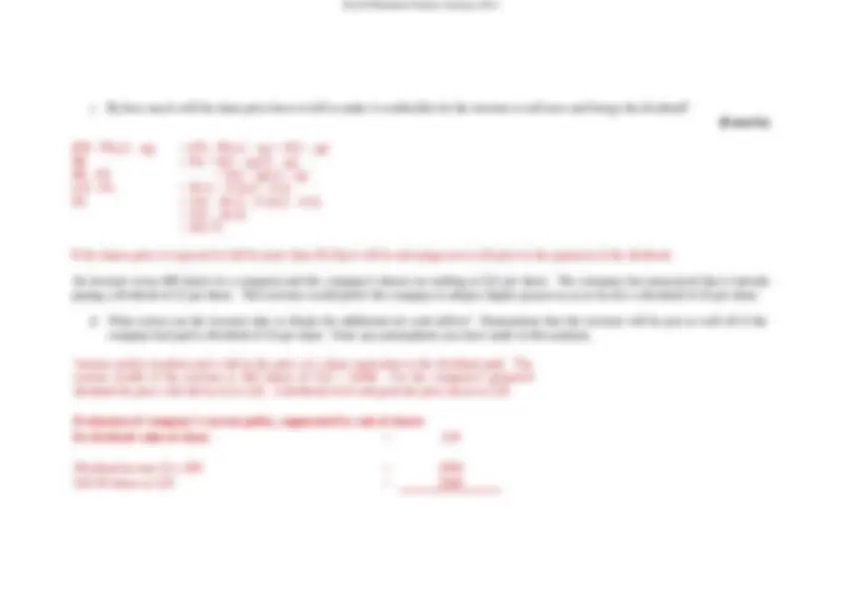
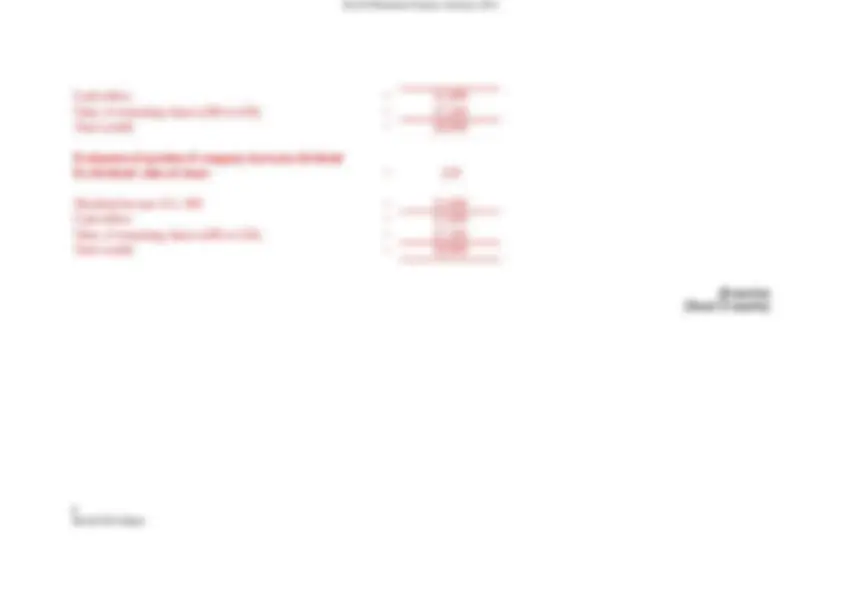
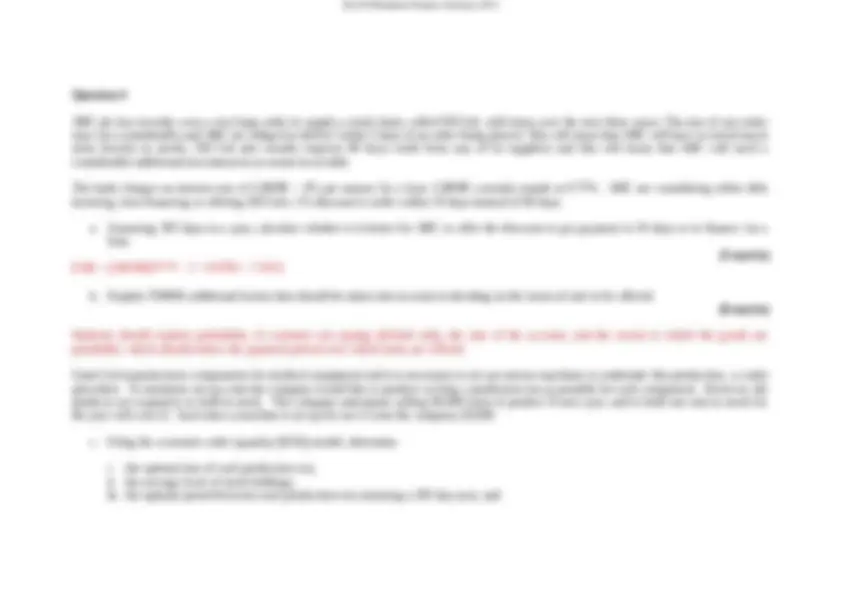








Study with the several resources on Docsity

Earn points by helping other students or get them with a premium plan


Prepare for your exams
Study with the several resources on Docsity

Earn points to download
Earn points by helping other students or get them with a premium plan
Community
Ask the community for help and clear up your study doubts
Discover the best universities in your country according to Docsity users
Free resources
Download our free guides on studying techniques, anxiety management strategies, and thesis advice from Docsity tutors
The january 2011 exam questions and solutions for the ag210 business finance course. It includes questions on investment analysis, rights offerings, payout ratios, and mergers and acquisitions. Students are required to answer one question from each section. The document also includes formulas and tables for calculating present value and future value of an annuity.
What you will learn
Typology: Exercises
1 / 23

This page cannot be seen from the preview
Don't miss anything!
















Calculators must not be used to store text and/or formulae nor be capable of communication. Invigilators may require calculators to be reset
8 Patrick McColgan
Corporate tax rates in the two countries are 30%. The UK government imposes no further taxes on cash flows received from the USA.
Assume for the purposes of evaluation:
For domestic investments RGB uses the CAPM where possible to determine the project discount rate. The nominal risk free rate in the UK is 3% and the expected return on the market portfolio is 9%. The asset beta for this project is 155.
a. Calculate the CAPM determined discount rate to be used in the evaluation of the UK project. (4 marks)
Rs = Rf + Beta * (Rm – Rf) = 3% + 1.55 * (9% - 3%) = 12.30%
b. Discuss the limitations of the CAPM for determining the opportunity cost of capital for a project. (6 marks)
Single period model, statistical uncertainty over appropriate expected market risk premium, empirical limitations relative to multi-factor pricing models, difficulties in estimate beta forecast forward, etc.
For both c) and d) it is recommended to express your working for all cash flows to two decimal places in millions, i.e. $22.25million.
c. Calculate the net present value of the UK investment project using a discount rate of 12%. (12 marks)
UK Investment 0 1 2 3 4 5 Net cash flows £7.30 £11.00 £12.50 £13.13 £13.
8 Patrick McColgan
by the relative purchasing power parity relationship. Again, assume a 12% discount rate for sterling cash flows. (18 marks) US Investment
(Total 50 marks)
Question 2
JJ Plc’s is a small retail banking firm, whose share price has declined during the global financial crisis since mid-2007 from a high of 1,200pence per share. The stock is currently trading at a price of 400pence and the company has 50million shares in issue. The company plans to announce a rights issue tomorrow to raise £100million to eliminate the company’s debt, given fears over investor’s attitudes to debt and the company’s financial stability during the credit crunch. The financial restructuring will also aid the company to comply with the recently announced Basel III recommendations in advance of the required date in several years time.
Given high uncertainty in the banking industry at present, it is proposed that JJ Plc will require having the issue underwritten and offered at a 50% discount to the current market price. Since the new issue is being carried out to reduce debt, it is not expected to have any impact on the expected earnings before interest and taxes (EBIT), which is forecast at £20million for the forthcoming financial year-end. The company currently has £100million in borrowings paying a fixed interest rate of 7%.
As the finance director of the company you have been asked to provide the following information to the company’s board of directors:
a. Specify the terms of the rights offering; covering the subscription price of the new issue, the number of new shares to be offered, the exchange ratio, the theoretical ex-rights price and the value of a right to buy one new share. (10 marks)
Cum price £4. Discount 50.00% Rights price £2. F £100,000,000. N 50,000, Δ N 50,000, rB 7.00% TERP £3. Value of a right £1. Exchange ra�o, 1 for 1
8 Patrick McColgan
Sell rights to buy 33,333.33 shares @ 100p £33,333. Own 50000 shares, Lose Cum Price - TERP -£50,000. Net gain / loss from tail swallowing £0.
Students can get to this result in any number of ways and full credit given for any approach
c. Assuming a corporate tax rate of 30% calculate the company’s earnings per share (EPS) under the current capital structure and that proposed under the zero-debt policy following the company’s rights issue. You should also highlight the break even level of EBIT where the company will be indifferent between the existing and new financing policies. Briefly comment on your findings. (12 marks)
DEBT NO DEBT £million £million EBIT 25000000 25000000 Interest -7000000 0 EBT 18000000 25000000
Taxes -5400000 - PAT 12600000 17500000
Number of shares 50,000,000 100,000, EPS 0.252 0.
Break even EBIT = £14,000,000.00 (Nu x Interest) / Nu - Ng
EPS decreases because a) more shares in issue and b) company is paying higher taxes due to the interest tax shield lost by reducing the company's debt levels.
8 Patrick McColgan
d. Explain why companies may choose to employ a deep discount in setting the subscription price for their rights offering. With reference to your answer in part c) comment on the view that deep discounted rights offerings are unattractive to companies because they lead to greater decline in EPS than would be observed for an issue made at a more conventional discount. (15 marks)
Students should explain the basic premise that companies can use a larger subscription price discount to ensure that the value of a right to purchase one new share in the offering remains positive even if the current market price declines over the rights period. The greater the discount, the less chance there is of the TERP dropping below the subscription price for new shares. As highlighted in c, the more shares the company has in issue, the lower the earnings per share of the company. As the subscription price discount increases, the number of shares to be offered in exchange for the required funds must also increase, leading to a greater dilutive impact on earnings per share. Students should also highlight the fallacy in this argument, showing that total earnings accruing to the investor for a fixed capital investment are the same irrespective of the subscription price discount.
(Total 50 marks)
c. By how much will the share price have to fall to make it worthwhile for the investor to sell now and forego the dividend? (6 marks)
(PB - P0) (1 – tg) = (PA - P0) (1 – tg) + D(1 – tp) PB = PA + D(1 – tp)/(1 – tg) PB - PA = D(1 – tp)/(1 – tg) 210 - PA = 30 (1 – 0.3)/(1 – 0.2) PA = 210 – 30 (1 – 0.3)/(1 – 0.2) = 210 – 26. = 183.
If the shares price is expected to fall by more than 26.25p it will be advantageous to sell prior to the payment of the dividend.
An investor owns 400 shares in a company and the company’s shares are trading at £22 per share. The company has announced that it intends paying a dividend of £2 per share. This investor would prefer the company to adopt a higher payout so as to receive a dividend of £4 per share.
d. What action can the investor take to obtain the additional net cash inflow? Demonstrate that the investor will be just as well off if the company had paid a dividend of £4 per share. State any assumptions you have made in this analysis.
Assume perfect markets and a fall in the price of a share equivalent to the dividend paid. The current wealth of the investor is 400 shares @ £22 = 8,800. For the company’s proposed dividend the price will fall by £2 to £20. A dividend of £4 will push the price down to £18.
Evaluation of company’s current policy, augmented by sale of shares Ex dividend value of share = £
Dividend income £2 x 400 = £ Sell 40 shares at £20 = £
Cash inflow = £1, Value of remaining shares (360 at £20) = £7, Total wealth = £8,
Evaluation of position if company increases dividend Ex dividend value of share = £
Dividend income £4 x 400 = £1, Cash inflow = £1, Value of remaining shares (400 at £18) = £7, Total wealth = £8,
(8 marks) (Total 25 marks)
8 Patrick McColgan
iv. the total annual cost of operating this production and stock policy. (8 marks)
Q^ = 2 x 80,000 x 8,000/2 = 25,298.22 units Average stock holdings = 25,298.22 / 2 = 12,649.11 units Optimal order period = 25,298.22 / (80,000 / 365) = 115.42 days Total annual cost = 25,298.222/2 + 80,000/25,298.22*8000 = 50,596.
d. Explain the key assumptions of the EOQ model and comment on any shortcomings of these assumptions when using the model in practice. (6 marks)
Kay assumptions are: demand is known with certainty and is uniform over time, order level is constant, the cost of ordering is fixed and unrelated to order size, shortages / stock-outs do not occur, and the lead time on an order is zero. Limitations of each of these should be discussed.
(Total 25 marks)
[END OF SECTION B, SECTION C CONTINUES ON THE NEXT PAGE]
8 Patrick McColgan
Answer ONE question
Question 5
Explain and critically evaluate the various reasons put forward for merging with or acquiring another company. In each case you should provide relevant examples to illustrate your arguments, and explain whether these are more applicable to certain types of mergers and acquisitions activity (i.e. horizontal vs. vertical vs. conglomerate mergers). (25 marks)
Students should explain shareholder perspective, managerial perspective and financial explanations to begin with but the dominant focus in this question is on the shareholder’s perspective. Merger synergies may come in the form of revenue enhancement, cost savings, reductions in corporate taxation, or some combination of the three. Managerial motives requires discussion of the market for corporate control and the idea that takeovers can be a cause of, or correction for, managerial inefficiency. Financial motives cover diversification, bootstrapping, use of surplus cash and increased borrowing capacity. Examples of each should be provided.
Question 6
Explain what is meant by the trade-off model of capital structure choice. Explain the factors that contribute towards a target debt ratio under this model, and the empirical shortcomings of the theory.
Students should explain basic tax benefits of debt, agency costs of equity / benefits of debt which encourage the company to borrow more. Costs of debt to be discussed relate to agency conflicts between shareholders and debtholders and direct and indirect costs of bankruptcy. Students should highlight these using appropriate graphs.
Predictions of the model are that leverage is increasing with profitability, tangible assets and firm size, but decreasing with growth prospects, volatility of operating cash flows and the availability of non-debt tax shields. Shortcomings empirically are that profitable firms have less debt, firms appear to time equity issuance, and the negative stock price response to seasoned equity offerings.
Table A-1 Future Value of £1 at the end of n periods = (1+r)n